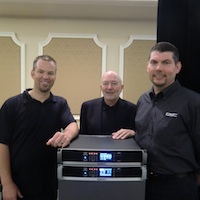
QSC is launching two new power amplifier families at InfoComm 2013 – CXD and PLD. CXD amplifiers are designed to meet the needs of integrators, while the PLD family is for portable live sound reinforcement. The two ranges share a common four-channel Class-D platform.
Pictured with models from the two ranges at a launch event on Tuesday are (L-R) Matt Skogmo (digital systems hardware architect), Jerry Tschetter (vice president, marketing) and Dale Sandberg (senior product manager).
The CXD series has been designed to address a number of demands from the installation market: multichannel amplifiers, with high power density (to minimise space usage in racks), on-board DSP, high efficiency, and the ability to drive low-impedance as well as 70/100V high-impedance loads.
One of the key features of these new amplifiers is what QSC calls Flexible Amplifier Summing Technology (FAST). A new MOSFET power drive enables power to be deployed across one, two, three, or four channels.
In any amplifier, all outputs – even bridged channels – are bounded by current and voltage limitations, and most of the power offered by bridging is at higher impedances. At low impedances, PLD and CXD are claimed to be unique in that they offer parallel channel combining for better utilisation of voltage for higher power.
To ensure that the correct channel configuration is selected, the new amplifiers provide a Preset Wizard. This is designed to simplify the amp set-up process and prevent confusion. Accessible via the front panel, the Preset Wizard also enables presets to be created, stored, recalled and edited. It assigns loudspeakers to outputs and loads the speaker tuning into the DSP. Tunings for approximately 70 models of speaker from around a dozen manufacturers are available, according to Dale Sandberg.
A PC/Mac GUI enables the monitoring and control of connected amplifiers. The GUI manages all presets, speakers and libraries and all amp and DSP parameters.
The amplifiers also feature multiple DSP-controlled power-saving modes, and power factor correction to align the current draw with the AC voltage, improving efficiency.







